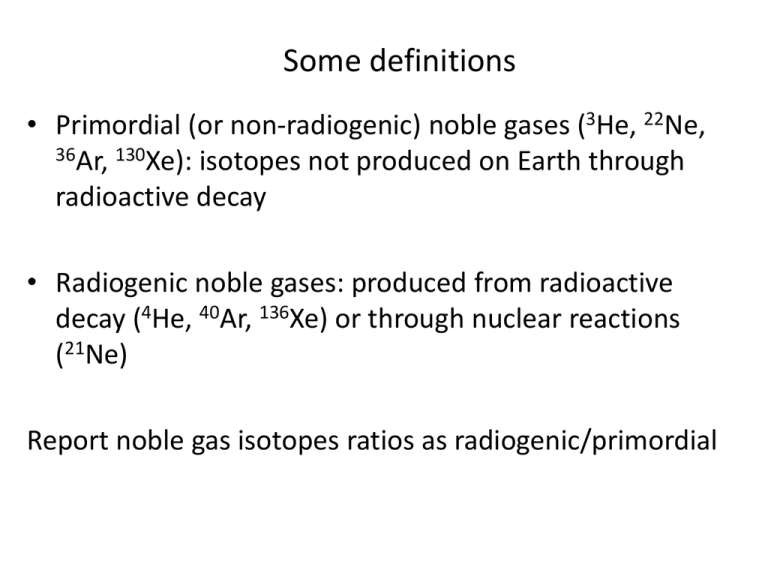slides
advertisement

Some definitions • Primordial (or non-radiogenic) noble gases (3He, 22Ne, 36Ar, 130Xe): isotopes not produced on Earth through radioactive decay • Radiogenic noble gases: produced from radioactive decay (4He, 40Ar, 136Xe) or through nuclear reactions (21Ne) Report noble gas isotopes ratios as radiogenic/primordial 40Ar/36Ar 20Ne/22Ne 3He/22Ne 3He/36Ar Mukhopadhyay, 2012 Plumes cannot supply all of the primordial noble gases to the MORB source. How does one explain the 3He/22Ne of the mantle? 12 10 3 He/22 Ne 8 6 4 2 0 Chondrites Sun Plumes MORB Honda and Macdougall (1997) suggested magma ocean degassing to explain the 3He/22Ne difference Post magma ocean the whole mantle was not homogenized with respect to its He/Ne ratio 129I 244Pu 129Xe; t1/2=15.7 My 136Xe; t1/2 = 80 My; 136Xe also produced from 238U spontaneous fission Popping rock (MORB) Black Airsquares Iceland Iceland? (OIB) Lower xenon excesses in OIBs 1. More shallow level air contamination for OIBs compared to MORBs 2. Preferential subduction of air or air saturated seawater into the OIB source 3. MORBs and OIBs have different I/Xe and (Pu+U)/Xe ratios 136Xe/130Xe MORB source 129Xe/130Xe is 7.9 ±0.14 from continental well gases. 129Xe/130Xe Holland and Ballentine, 2006 129Xe/130Xe Ar-Xe mixing constrains Iceland mantle 129Xe/130Xe Mukhopadhyay, 2012 Iceland mantle source 129Xe/130Xe constrained for the first time = 6.98±0.07 (MORBs = 7.9±0.14) Lower values in OIBs compared to MORBs are not related to shallow level air-contamination. 129I 244Pu 129Xe; t1/2=15.7 My 136Xe; t1/2 = 80 My; 136Xe also produced from 238U spontaneous fission Popping rock (MORB) Black Airsquares Iceland Iceland (OIB) Lower xenon excesses in OIBs 1. More shallow level air contamination for OIBs compared to MORBs X 2. Preferential subduction of air or air saturated seawater into the OIB source 3. MORBs and OIBs have different I/Xe and (Pu+U)/Xe ratios. Lower 129Xe/130Xe in Iceland compared to MORBs is not a result of preferential recycling of Air Air OIBs and MORBs separated by 4.45 Ga; subsequently mixing between MORBs and OIBs have to be limited. 129Xe -136Xe differences between Iceland and depleted MORB Iceland n=51 N. Lau plume SWIR MORB n=83 Eq. Atlantic MORB n=25 OIBs and MORBs separated by 4.45 Ga; subsequent mixing between MORBs and OIBs has to be limited. Mukhopadhyay, 2012; Parai, Mukhopadhyay & Standish, In review; Tucker, Mukhopadhyay & Schilling, In review Torsvik et al., 2010 (Also see Dziewonski et al., 2010) If plumes are derived from the LLSVPs then these are ancient and have persisted through most of Earth’s history (older then 4.4 Ga). Torsvik et al., 2010 (Also see Dziewonski et al., 2010) If plumes are derived from the LLSVPs then these are ancient and have persisted through most of Earth’s history (older then 4.4 Ga). Plume flux 1-2 1014 kg/yr, primordial material constitutes ~10-20% of total plume LLSVPs material could have constituted ~3-7% of mantle mass. Conclusions He/Ne ratios in the mantle remembers a magma ocean 129Xe/130Xe in OIBs reflect two reservoirs that evolved with different I/Xe ratios MORB and OIB sources were separated by 4.45 Ga and subsequent direct mixing between MORB and plume sources must have been limited over entire Earth history If LLSVPs are the source of OIB material, they are at least as old as 4.45 Ga. Moon forming impact did not homogenize the entire mantle The first billion year history of the atmosphere (and hydrosphere) Primary Atmosphere 1. Capture of Solar Nebular gases Secondary Atmosphere 1. Impact degassing 2. Delivery from icy meteorites and comets 3. Outgassing of the Earth’s mantle Composition of the earliest atmosphere • Reducing atmosphere: CH4, NH3, H2O (e.g., Urey 1951 – led to the famous Urey-Miller experiments on prebiotic chemistry) • Oxidizing atmosphere through volcanic outgassing: CO2, H2O (e.g., Rubey 1951) Why is the early atmosphere important? • The composition of the early atmosphere sets the boundary condition for surface chemistry prebiotic chemistry Deep mantle Neon says yes to incorporation of nebular gases Atmosphere depleted in lighter isotope (20Ne) Noble gases in the atmosphere of terrestrial planets 1. Massive depletion of volatiles from Earth 2. Abundance pattern looks like carbonaceous meteorites 3. Atmosphere does not remember the primary atmosphere Solar N/Ne ~1; terrestrial N/Ne ~86,000 =>most of the nitrogen delivered in condensed form. Formation of Early Atmosphere Primary Atmosphere 1. Capture of Solar Nebular gases Present day atmospheric noble gases do not remember the presence of a primary atmosphere Secondary Atmosphere 1. Impact degassing (while accreting) 2. Outgassing of the Earth’s mantle 3. Delivery from icy meteorites and comets (late veneer) Noble gases in the atmosphere of terrestrial planets 1. Massive depletion of volatiles from Earth 2. Abundance pattern looks like carbonaceous meteorites 3. Atmosphere does not remember the primary atmosphere So can chondrites deliver the noble gases and hence the other volatiles to Earth? Co-variation of D/H with N isotopes Earth volatiles: Signature of comets? Meteorites? Marty, 2012 What happened during the Moon-forming giant impact • Likely led to majority of the volatiles being in nearsurface environments • Magma ocean degassing: Atmospheric C-O-H species controlled by magma ocean fugacity • Zonation in fO2 in the magma ocean but surface likely to be in equilibrium with H2O-CO2 Hirschmann, EPSL, 2012 Earth atmosphere depleted in lighter isotopes compared to sun but enriched compared to chondrites Earth atmosphere depleted in lighter isotopes Hmmmm…… 20Ne/22Ne 13 12 11 10 9 8 Chondrites Atmosphere Mantle Sun Observation: Atmosphere is enriched in the heavier isotope compared to the mantle Explanations 1) Outgas the mantle followed by hydrodynamic escape of a H2 rich atmosphere (e.g., Pepin, 1991) 2) Atmosphere is a mixture of outgassed mantle gases and later accreting material (late veneer) Atmospheric noble gases: Mantle outgassing or late veneer? Iceland, max measured Marty, 2012 128Xe/130Xe MORBs and OIBs have non-atmospheric primordial Xe isotopes 129Xe/130Xe Well gas data from Caffee et al., 1999; Holland and Ballentine, 2006 Mukhopadhyay et al., In prep Kr in the mantle and the atmosphere Holland et al., 2009 Evidence that the atmosphere cannot form through mantle outgassing i.e. its from a late veneer after the giant impact Mantle outgassing followed by mass fractionation Mantle Atmosphere Increasing 128Xe/130Xe Mantle Atmosphere Increasing 82Kr/84Kr But late veneer is NOT carbonaceous chondrites Earth atmosphere looks neither like sun nor like chondrites What happened next (and during)? • During end of accretion, heavy bombardment likely maintained hot, steam atmosphere • Oldest zircons (possibly 4.3-4.4 Ga) indicate very early formation of a continental crust – Measurements of oxygen isotope ratios in zircons indicate liquid water at the earth’s surface • “Impact frustration” on the development of life immediately after accretion - How long did this period last? • Impacts can help and hurt atmosphere formation and prebiotic chemistry – Only a few impacts could deliver the Earth’s ocean water – Large impacts could have blown off several generations of early atmospheres – Impact degassing can produce reducing atmosphere Basin scale impacts can produce steam atmospheres Zahnle et al., 2011 2500 km diameter Basin scale impacts can produce steam atmospheres Zahnle et al., 2011 Atmospheric composition produced through impact degassing of ordinary chondrites: Quite reducing Schaefer and Fegley, 2010 Also see Hashimoto et al., 2007 and Schaefer and Fegley 2007 Atmospheric composition produced through impact degassing of carbonaceous (CI) chondrites: Substantial amounts of reducing gases Schaefer and Fegley, 2010 Also see Hashimoto et al., 2007 and Schaefer and Fegley 2007 Metamorphosed pillow basalts at Isua Banded iron formation in 3.6-3.8 Ga Isua metasediments 3.8 Ga Akila metasediemnts Sedimentary (water-lain) rocks by 3.8 Ga oceans established by 3.8 Ga The faint young sun paradox High concentration of greenhouse gases required to keep the planet above freezing Kasting, 2010 Mass independent fractionation in sulfur isotopes: Interaction of the mantle with the surface reservoir? Halevy et al., 2010 Summary • • • • Nebular gas signature present in deep mantle Transition from solar (nebular) gases to more ‘chondritic’ gases Atmosphere and mantle have not been completely homogeneized Atmosphere likely related to late veneer; BUT no known meteorite can match the noble gas pattern • Post giant impact atmosphere could have been reducing or oxidizing. • Liquid water at surface by 4.3 Ga; impacts may have prevented stable ocean for the first few hundred million years; stable oceans likely by 3.8 Ga • High concentrations of greenhouse gases required to keep the planet above freezing in the Archean.









